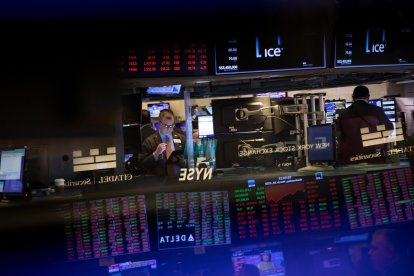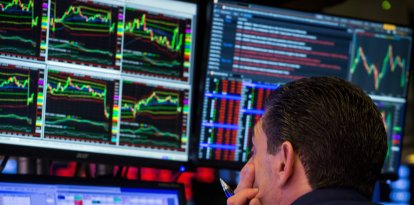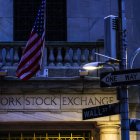Global stock markets falter as they await key U.S. unemployment data
Poor economic indicators from the world's leading power, the technology sector and fears of a bad employment data mark a week of losses in the main international markets.

Traders at the New York Stock Exchange in a file image.
Fear. It's the word that best defines the situation in international markets this week. The highly anticipated yet concerning release of U.S. employment data this coming Friday has set a downward trend for the past three days -the US stock markets were closed on Monday for the Labor Day holiday-. In addition. the fear that another poor report will confirm the economic decline of the world's leading power has been compounded by a series of worse-than-expected indicators and the poor performance of tech stocks, particularly Nvidia, which has lost 11% of its value (more than $280 billion) in the first days of September.
Despite the fact that the main U.S. markets managed to contain losses by the end of Wednesday's session, the day closed in the red for the major international stock exchanges. The over 4% plunge of Japan's Nikkei and continued losses in European capitals, some very concerning, like the drop of Spain's IBEX below the 11,200-point mark for much of the day -though this psychological threshold was eventually recovered- raised fears about the performance of North American indexes. In fact, the session started off very poorly, though it eventually managed to stabilize.
Tuesday, the worst day on the US stock markets since Black Monday
September is traditionally complicated for the stock market world, but the first days of the month this year have been especially difficult. The opening of the US stock markets on Tuesday, after Monday's holiday, was the starting signal for a chain reaction that stained the world's stock markets red. On the first day of the week, the Dow Jones lost 1.51%, while the S&P 500 (-2.11%) and, especially the Nasdaq 100 (-3.15), were even worse, marking the worst data since the black Monday August 5 after panic triggered by U.S. unemployment data in July.
The technology company Ndivia was the center of attention when it slumped 9.53%, with capitalization losses of nearly $280 billion. These falls would continue during Wednesday's session, although much more contained. Also weighing on the stock markets was the worse-than-expected factory activity in the US. Although slightly better than the previous month's data, the Institute for Supply Management (ISM) data confirmed that domestic industry has been in contraction for 21 of the last 22 months, after standing at 47.2 points in its latest reading.
Asian and European markets in the red
The red extended to the Asian markets, which closed Wednesday with significant falls and which also recalled the fateful August 5. The Japanese Nikkei lost more than 4% during the day, while the Shanghai Stock Exchange and the main Asian indicators also ended the day in the red. The macroeconomic data released by China came in worse than expected, which did not help the situation.
The main European trading floors continued to trend lower, with particularly tough moments around the middle of the day, coinciding with the opening of U.S. markets and the release of data such as Job openings (JOLTS) in the U.S., which was worse than expected. The 8.1 million expected fell to 7.6 million in July, the lowest level since 2021. Moreover, while hiring held up, layoffs increased by 200,000 people during this month.
At the close of this news, the Nikkei was down 1.05% on Thursday, weighed down by the appreciation of the yen and the performance of technology companies, while European markets also opened with losses, albeit moderate.
RECOMMENDATION






















